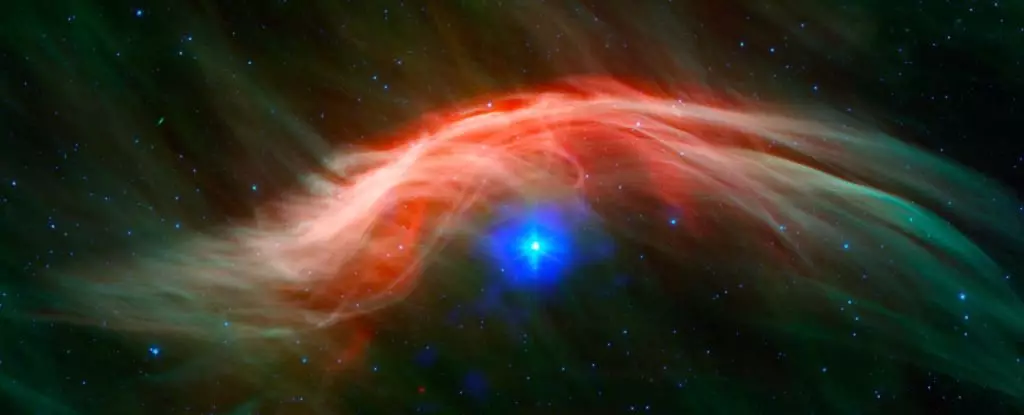The universe is a vast expanse, often perceived as detached from the minutiae of life on Earth. However, new research suggests that cataclysmic events in space, such as supernova explosions, may hold unexpected significance for terrestrial life, particularly in relation to microbial diversity. A study focusing on Lake Tanganyika in Eastern Africa reveals a compelling correlation between an increase in viral diversity around 2.5 million years ago and a nearby supernova’s cosmic ray emissions. This nexus of cosmic and biological phenomena raises profound questions about the interconnectedness of terrestrial life and celestial events.
Supernovae are the dramatic deaths of stars that can release an astronomical amount of energy, propagating waves of radiation that traverse the cosmos. As Caitlyn Nojiri and her team from the University of California Santa Cruz assert, it is indeed fascinating to consider how events occurring millions of light-years away could potentially influence evolutionary paths on Earth. The interplay between cosmic radiation and evolutionary mechanisms invites further examination, particularly in understanding how such external influences may have catalyzed biological transformations throughout Earth’s history.
Earth resides within a region known as the Local Bubble, a space relatively free from neighboring stars. It is theorized that this bubble was shaped by a series of supernova events, resulting in a distinctive environmental context for the development of life on our planet. The scientists involved in the study sought to investigate the extent to which radiation from nearby supernovae contributes to evolutionary pressures on Earth. By examining deep-sea sediment core samples, they focused on iron-60, a radioactive isotope formed during supernova explosions and subsequently deposited on Earth.
Earlier studies identified two significant spikes of iron-60 in seafloor sediment, with one dating back approximately 6.5 to 8.7 million years and the other to between 1.5 and 3.2 million years ago. The current research aimed to link these iron-60 deposits to specific supernova events. Their results revealed that the more recent spike of iron-60 coincided with a period when Earth likely experienced intense cosmic radiation due to a supernova explosion in the vicinity.
Upon further investigation, Nojiri’s team hypothesized that the nearby supernova explosion stemmed from either the Scorpius-Centaurus stellar group, located about 460 light-years away, or the Tucana-Horologium group, roughly 230 light-years distant. The Scorpius-Centaurus group, noted for its pulsar— the remnant of a supernova, emerged as the strongest candidate for the event. Supporting this hypothesis, earlier research had already linked the iron-60 spike to a specific supernova in that region.
What is particularly striking about these findings is not merely the presence of cosmic material on Earth but the potential biological implications of the corresponding radiation. Computer simulations suggested that a supernova near either of these groups would expose Earth to intense cosmic radiation for at least 100,000 years. This could elevate radiation doses significantly, potentially influencing evolutionary processes, particularly in environments rich in life forms like the biota around Lake Tanganyika.
The study highlights a pivotal threshold for radiation absolutely necessary to invoke notable biological changes. Historical research indicates that levels above 5 milligrays per year pose risks for DNA alterations, which can lead to mutations. Given the estimated radiation increase from supernova influences—ranging from 30 to 100 milligrays per year—it is plausible that such conditions could incite significant changes in local ecosystems.
In Lake Tanganyika, a remarkable observation has revealed an increased viral diversity corresponding with the period following the supernova event. While direct causality is difficult to establish, the temporal correlation is undeniable, providing a tantalizing glimpse into how cosmic events may be woven into the tapestry of life on Earth. Caitlyn Nojiri’s research champions the idea that not only does the Earth exist in a cosmic bubble, but these vast and violent celestial occurrences can subtly guide the biodiversity we encounter today.
As we contemplate the ramifications of these findings, we are reminiscent of the words of the late Carl Sagan, who astutely observed that “we are all stardust.” The intricate web of life is perhaps less isolated than we imagine, influenced by forces playing out across the cosmos. It compels us to consider the broader implications of such research not only for our understanding of evolution and ecology but also for how we perceive our place in the universe. The ongoing exploration of these cosmic connections may unearth further mysteries of existence, reshaping our comprehension of life’s origin and development on Earth. In synthesis, we must acknowledge that the universe, in its grand tapestry, intricately threads together the fate of all life—transforming distant explosions into agents of change on our blue planet.

